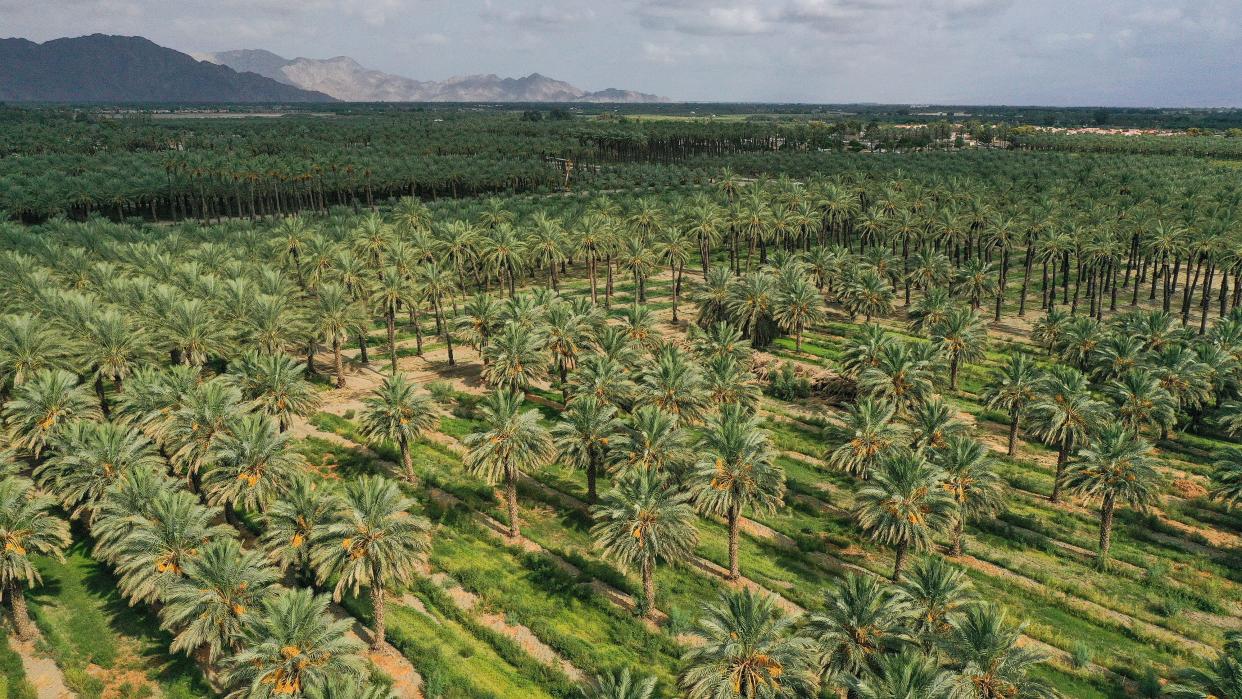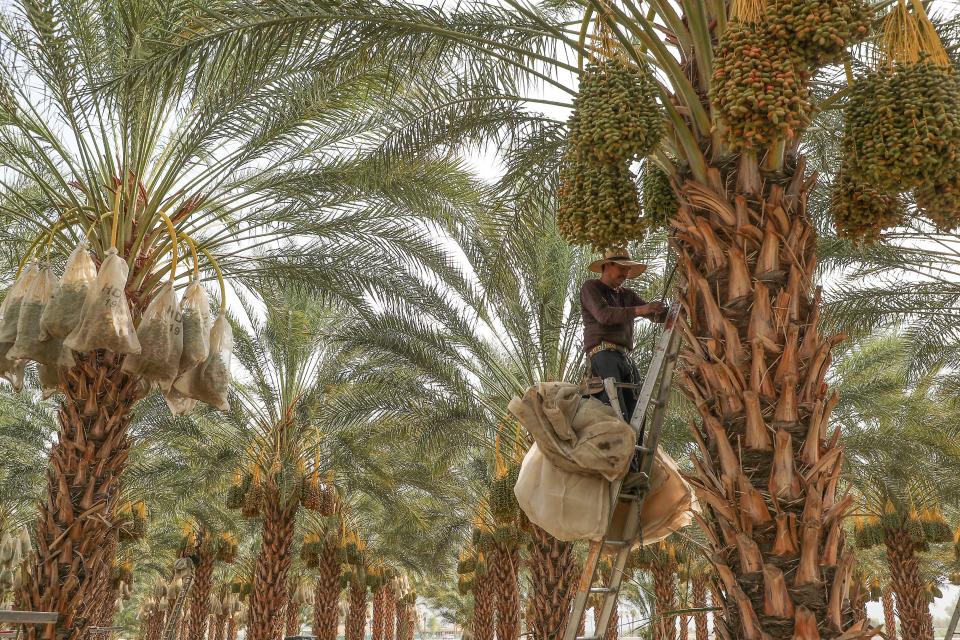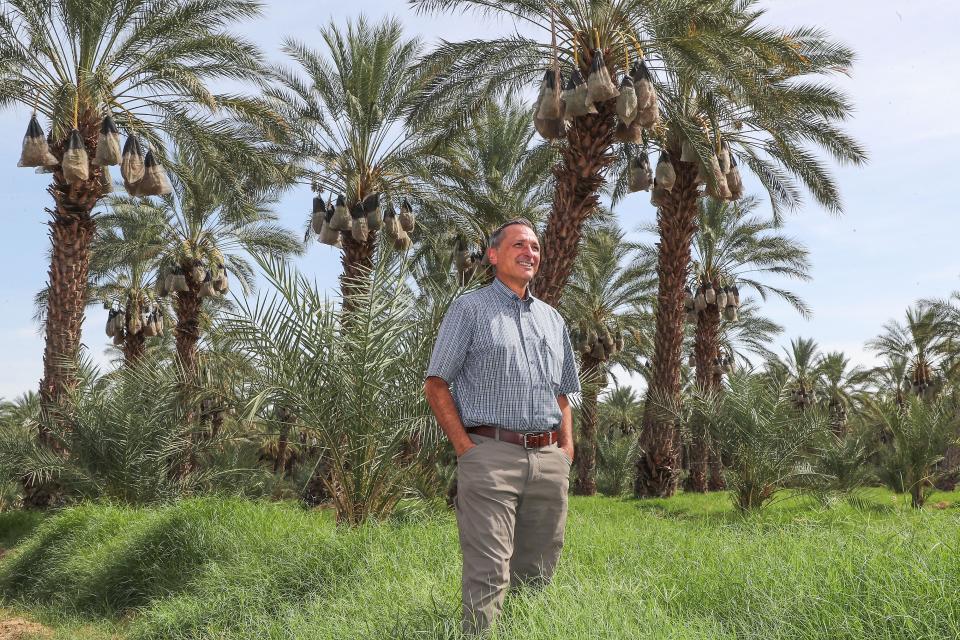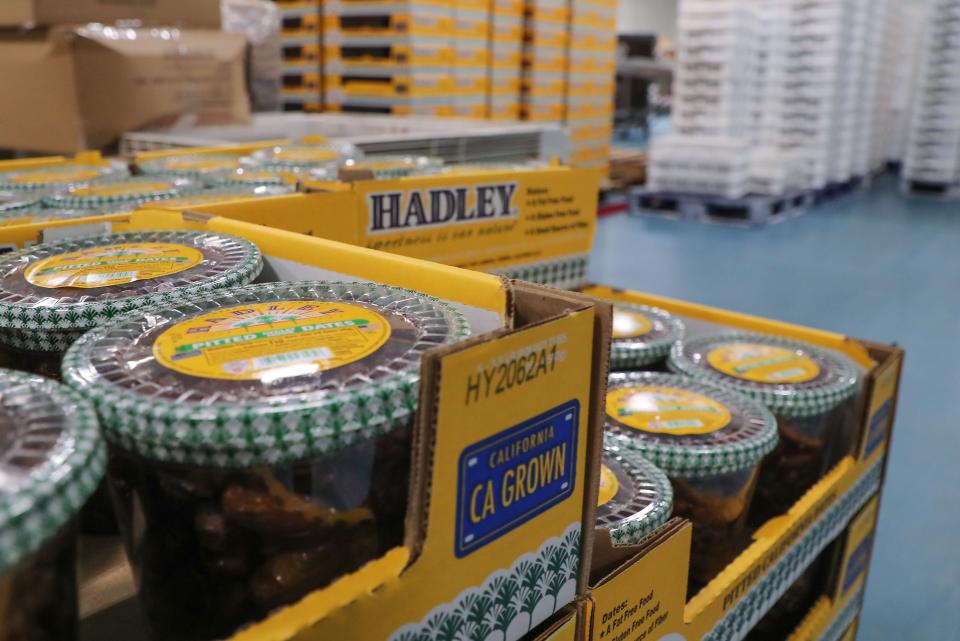Coachella Valley date farmers try to chart a future amid inflation and historic drought

George Tudor's farm, which grows grapes and dates in the Coachella Valley, managed to avoid major disruptions when the global supply chain crisis struck in 2021, thanks in part to buying early.
Not this year.
“It's been wild,” said Tudor, whose family has been farming in the east valley for decades. “I would estimate that some things have gone up 50%, 60%, and some have gone up 100% … A fertilizer I use went from $25 to $56, something like that.”
Tudor, who specializes in grapes but also grows dates and lemons, is quick to note these prices are as much a result of supply chain issues, amplified by Russia’s war against Ukraine, as the country’s spiking inflation rates.
But throughout this year, farmers in the Coachella Valley and beyond have started to feel the pinch of inflation reaching a 40-year high, with record-breaking gas prices causing freight and shipping costs to rise for every industry, including agriculture.
“If freight goes up 25%, 30%, the retailer sticks it to the farmer — always, always, always,” Tudor said. “The grocery store will upcharge you and say it's inflation, but when the grower asks the grocery store, ‘We need $2 or $3 more a box for inflation,’ they laugh at you and call the person next door, or the person across the border.”
Several of those affected are in Vista Santa Rosa, a largely agricultural and equestrian area of about 8,000 acres just east of La Quinta and south of Coachella and Indio. Anyone who drives south along Monroe Street from Interstate 10 will notice the area, as burger joints and country clubs soon give way to date palm trees aligned in perfect rows, with an occasional residence tucked away on the sprawling properties.
From their outposts in the California desert, several valley farmers were keen to point out they are "price takers, not price makers," leaving them in a precarious position within competitive global markets.
But the rising costs of doing business aren’t the only thing that has farmers worried. With the Colorado River’s reservoirs in severe decline, major water cuts are a growing possibility for farmland in southeastern California, adding an underlying layer of anxiety that inflation has only worsened.
“I'm terrified, and there shouldn't be a single person, resident or farmer, that isn't,” Mark Tadros, a date grower who runs Aziz Farms in Vista Santa Rosa, said of potential water cuts.
‘That market will replace you’
While farmland for other key local crops, including grapes, has shrunk since the start of the century, the valley’s date industry has experienced a substantial renaissance.

While valley farmland used for grapes shrank by nearly 60% between 2000 and 2020, more than 2,600 new acres of date palms were planted, a 38% jump, according to a prior analysis by The Desert Sun of Coachella Valley Water District data.
In 2020, dates covered the most acres of any crop in the valley, and had the highest total value at roughly $83 million, according to CVWD’s most recent annual report. Grapes were second at about $73 million, while bell peppers were third at roughly $67 million.
More: Agricultural overhaul: Coachella Valley farmland shrinks as dates replace grapes
More: La Quinta, Coachella renew simmering turf war over Vista Santa Rosa area
The rise of dates can be attributed to several factors, said long-time local farmer Albert Keck: healthier diets among younger folks, a rise in date palms’ popularity for landscaping and a unique climate in the Coachella Valley that allows for reliable growth.
But as he sat in his Vista Santa Rosa office on a recent summer morning, Keck ran through a long list of things that make him worry about the future of dates — and agriculture more generally in California.
“Little by little by little, what we're seeing is the depletion of our agricultural capacity for the specialty crops in California, and in Coachella, you might be seeing it with dates in the future,” said Keck, who runs Hadley Date Gardens in the Vista Santa Rosa area.

Similar to Tudor, Keck says he’s seen prices for everything from cardboard to fuel rise by as much as 50% in his latest round of orders. That adds to his steadily rising costs, much of which goes to pay his workforce of about 100 employees.
Additionally, Keck — who chairs the California Date Commission, which offers regulatory and marketing support to local growers — said international companies have ramped up production of the two most popular dates grown in the U.S., the medjool and the Deglet Noor. That potentially threatens the country’s strong foothold in the export market.
“It's a global market, so then they go, ‘Well, Hadley, you're kind of expensive, so we're going to go and get our stuff from Turkey or from Tunisia or something like that,’” Keck said. “It's like, wait a sec. You're going over there because we're 20 cents higher than them?”
Yet global competition in agriculture is a “fact of life,” and California farmers rely heavily on those markets to export a wide range of crops, according to Bruce Babcock, a professor at the University of California Riverside who specializes in agriculture policies.
California historically produces more than 90% of the nation’s dates, with much of that farming in the Coachella Valley. The Golden State also has the lion’s share of dates exported outside the U.S., making it dependent on a reliable supply chain and steady international demand for its products.
“When there are all these logistical issues of the last year, and you have an export market that you've been dealing with for a long time, and then all of a sudden, you can't ship to that market for whatever reason … they still have a market, and they will fill it one way or another,” Tudor said.
“All of a sudden, even if it's only for a year or two, that market will replace you," he added.
Growers always have their eye on market changes, and Babcock said the Coachella Valley could be in store for another transformation.
“If dates fall out of favor or if other countries get a competitive advantage over Coachella Valley date producers, then date production will go down much like grape production went down,” Babcock said.

Tadros, whose date operation is smaller than Keck’s, said he thinks many of the issues facing local growers will impact smaller operations more immediately.
“I think some of these smaller 5-, 10-, 15-acre farming operations are the ones that we're going to see be very heavily affected by some of these increases much faster,” Tadros said.
The amount of imported fruit coming to the United States has skyrocketed, rising 129% between 2000-02 and 2017-19, a new U.S. Department of Agriculture report shows. That helps consumers have fresh fruits year round, but the report says competition can also “put downward pressure on prices, which can result in reduced U.S. production.”
‘Terrifying’ water cuts loom
But amid rising costs and competitive markets, industry growers and experts say the larger, looming issue is the potential for cuts in water diverted from the Colorado River to farmers in the eastern Coachella Valley, Blythe and Imperial County.
"If I was in the Coachella Valley, I'd be worried about the Colorado River more than anything, more than inflation," Babcock said.
In June, a top federal official called on the seven states that manage the river to agree on water cuts that total at least 2 million acre-feet — nearly half of California’s annual allocation from the river — by mid-August.
It’s unclear how the cuts will immediately impact local agriculture. The Coachella Valley Water District, which covers much of the central and east valley, hasn't agreed to any new water cuts yet. An official in the nearby Imperial Irrigation District told The Desert Sun this week that CVWD “has offered us the sweat of their brow basically, nothing more” in negotiations.
Still, farmers here are expecting impacts at some point.
“The system developed on a priority basis, and 40 million people have less priority than farmers,” Keck said, referring to the state's population. “I don't know what's going to happen, because the reality is, if 40 million people don't have water, something's gonna happen.”
Keck said he worries about bigger cities using their “political muscle” to steamroll California’s rural inland communities and take legal priority in the system.
“We have permanent crops here,” Keck said. “If you don't water your crops, you lose your orchard, and there's thousands of dollars of investment per acre there you're not going to get back.”
More: California drought 2022: Two water districts eye hefty Colorado River cuts
More: Feds float drastic measures to stanch California's water crisis
On the bright side, dates are more sustainable than many other crops, and multiple farmers noted water practices in the industry have become more efficient.
Tadros, the second-generation farmer with Aziz Farms, said he’s terrified of the potential water cuts not just for himself, but also for the industry’s future in the valley.
“I've got a 6-year-old and a 3-year-old, and the proposition of them being on a phone call one day talking about how they don't get any water at all is very real, and it's very terrifying,” Tadros said.
Weeks ahead of the mid-August deadline and a potential decision on initial cuts, farmers in the valley were uncertain of what an announcement might mean for them. One possibility — and something that farmers have already begun in Arizona — is to leave land fallow, but that's less feasible for date trees, which need steady watering to survive.
“We don't know what's going to happen, so it's a looming crisis. We're very concerned about it, but we're here,” Keck said, motioning around at the date trees rising more than 50 feet into the air. "This is Vista Santa Rosa, and we're growing dates.”
Most farmers interviewed for this story still had optimism for dates’ future in the Coachella Valley. Tadros, whose family has been in the business for more than 30 years, said despite "a rough year," he’s hopeful conditions will improve.
“I hope inflation drops down and quells off a little bit, gas prices go back to normal, and then the hope is that people don't keep these inflated prices for higher profits,” Tadros said. “Instead, the prices kind of start to trickle down, and the volume goes back up, and the profitability is there for the farms and farmers.”
Tadros paused.
“Can I honestly tell you that everything's going to get better? No,” he said. “I think a lot of times things have to get worse before they can get better, and I don't think we've seen the bottom yet.”
Tom Coulter covers politics and can be reached at thomas.coulter@desertsun.com or on Twitter @tomcoulter_.
This article originally appeared on Palm Springs Desert Sun: California drought and inflation hitting Coachella Valley date farmers

